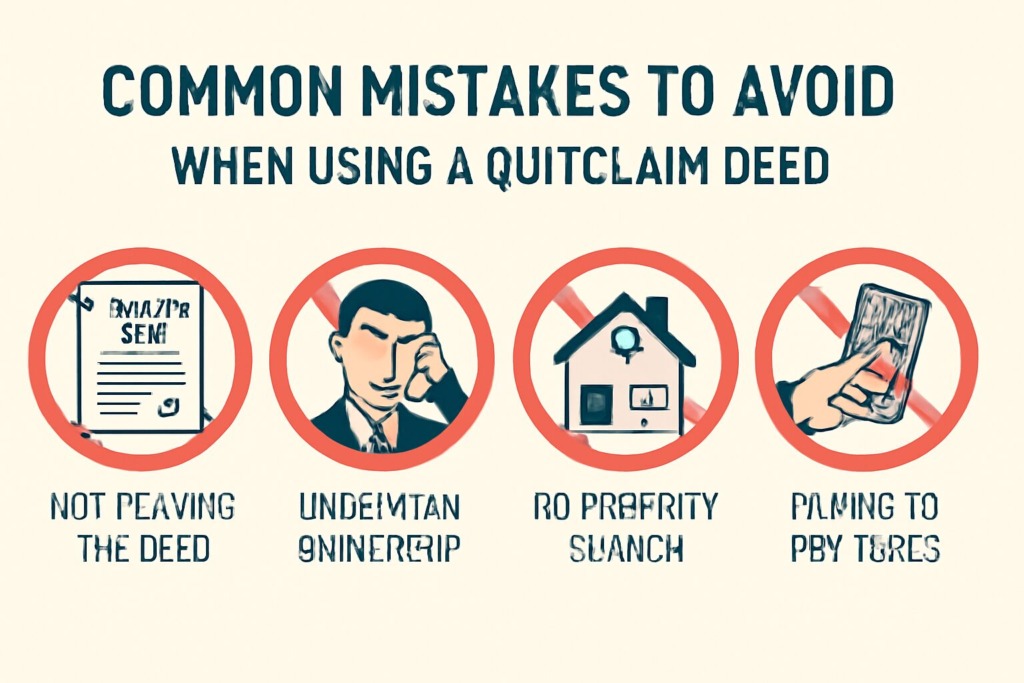When navigating the world of real estate transactions, you’ll encounter various legal documents designed to transfer ownership or make adjustments to property titles. Among these documents, the quitclaim deed stands out as one of the most commonly used tools. But what exactly is a quitclaim deed, and how does it differ from other types of deeds?
A quitclaim deed is a simple legal instrument that allows one party (the grantor) to transfer whatever interest they have in a property to another party (the grantee). While this deed is straightforward, it comes with important considerations regarding its use and legal implications. Whether you’re transferring property within your family, correcting title errors, or engaging in a real estate transaction, understanding quitclaim deeds is essential.
In this guide, we will walk through everything you need to know about quitclaim deeds, including when they should be used, the associated risks, and how to execute them properly. We’ll also compare quitclaim deeds to other types of deeds, explore their benefits and drawbacks, and provide guidance on avoiding common pitfalls. Let’s dive in!
1. What Is a Quitclaim Deed?
A quitclaim deed is a type of deed used to transfer ownership or interest in a property. Unlike other deeds that guarantee the title’s validity, a quitclaim deed offers no warranties or guarantees about the property’s condition or the grantor’s ownership. This means that the grantor only transfers whatever interest they may have in the property—if they even have one. If a grantor has full ownership of a property, the deed will transfer that ownership, but if the grantor does not own the property, no ownership will transfer.
While this may sound risky, quitclaim deeds are still incredibly useful in certain situations, particularly when the parties involved trust one another or when the deed is being used to correct a title issue. The lack of guarantees is why quitclaim deeds are often used in family transfers, estate planning, and divorce settlements.
To clarify, let’s break down some key terms:
- Grantor: The person transferring the property interest.
- Grantee: The person receiving the property interest.
- Property Interest: The rights or ownership the grantor holds in the property being transferred.
For example, if a family member wishes to transfer their property to another family member, they can use a quitclaim deed to transfer the ownership interest without having to guarantee that the property is free of debt, liens, or encumbrances.
2. Scenarios When a Quitclaim Deed Is Used
While a quitclaim deed can technically be used in any situation where ownership of property is being transferred, there are specific scenarios where it’s commonly employed. Here are the most common instances:
Family Transfers
One of the most frequent uses of quitclaim deeds is for family transfers. Whether you are transferring property to a child, spouse, or sibling, a quitclaim deed simplifies the process. This is particularly useful when the parties involved have an established trust and no concerns about property title issues. For instance, parents may want to transfer their home to their children without involving the complexities of traditional property transfer documents.
Divorce and Separation
During a divorce, the division of assets includes real estate. A quitclaim deed is commonly used to transfer ownership of the marital home or other property from one spouse to the other. By using a quitclaim deed, the transferring spouse relinquishes all claims to the property without having to guarantee the title’s quality. This can be a simpler and quicker process compared to other methods of property division.
Real Estate Transactions
In some real estate transactions, particularly short sales or when clearing up title issues, a quitclaim deed may be used to transfer ownership. For instance, when a seller wants to transfer property but is unable to offer a warranty deed due to legal complications, a quitclaim deed allows for the transfer to take place quickly.
Trusts and Wills
In estate planning, quitclaim deeds are often used to transfer property into a living trust or to heirs after a person’s death. This allows for smooth estate distribution without the need for formal probate proceedings. Quitclaim deeds for inheritance can simplify the process, especially when the property was jointly owned or when only a partial interest is being transferred.
Fixing Title Defects
If there is a title defect—such as a spelling error in the deed or unclear ownership rights—a quitclaim deed is often the fastest solution to clear things up. For example, if two individuals have shared ownership of a property but one person’s name is incorrectly spelled on the title, a quitclaim deed can be used to correct the record without any legal issues.
3. Understanding the Risks of Quitclaim Deeds
Although quitclaim deeds are efficient and convenient, they come with risks that should not be ignored. Let’s take a closer look at the potential legal complications:
No Title Guarantee
One of the most significant risks associated with quitclaim deeds is that they do not guarantee clear title to the property. Unlike a warranty deed, which ensures that the property is free of any debts, liens, or ownership disputes, a quitclaim deed only transfers whatever interest the grantor has at the time of transfer. If the grantor’s title is flawed or if they don’t fully own the property, the grantee may be left without any legal claim to the property.
“For additional legal perspectives, read more about quitclaim deeds from trusted sources like Investopedia.”
Risk of Liens
Since a quitclaim deed doesn’t promise that the property is free of encumbrances, there’s a risk that the grantee may inherit liens or other financial obligations tied to the property. This includes unpaid mortgages, tax liens, or judgments. If the property is later found to have unresolved liens, the grantee may be responsible for settling those debts.

Fraud and Abuse
The simplicity of a quitclaim deed makes it prone to fraud. Unscrupulous individuals may try to fraudulently transfer property without the true owner’s consent. For example, a fraudulent party could forge a quitclaim deed to transfer a property to themselves or to another unsuspecting buyer. To prevent such fraud, it’s essential to have a title search done before accepting a quitclaim deed.
Mortgage Impact
A common misconception is that a quitclaim deed will release the grantor from any mortgage obligations. However, signing a quitclaim deed does not eliminate the mortgage responsibility. The original borrower is still liable for the mortgage unless the loan is refinanced or paid off.
4. Step-by-Step Guide: Executing a Quitclaim Deed
If you’re considering using a quitclaim deed, here is a step-by-step guide to ensure the process goes smoothly:
Preparing the Deed
The first step is to gather the necessary information. This includes:
- Grantor’s name and address: The person transferring the property.
- Grantee’s name and address: The person receiving the property.
- Legal description of the property: The full legal description of the property being transferred, which can be found in the property’s current deed.
- Property address: The physical address of the property.
Signatures and Notarization
Once the deed is prepared, both the grantor and grantee must sign it in front of a notary public. The notary verifies the identity of the parties involved and ensures that the deed is signed voluntarily. Notarization is critical for the validity of the quitclaim deed.
Filing the Deed
After the deed is signed and notarized, it needs to be filed with the county recorder’s office in the county where the property is located. This officially records the transfer of ownership in the public record. Without filing the deed, the transfer may not be legally recognized.
Post-Filing: What Happens Next
Once the quitclaim deed is recorded, it becomes part of the public record. The new grantee’s ownership interest is officially recognized. However, as noted earlier, it’s essential to perform a title search before finalizing the transfer to ensure the property is free of issues like liens or unresolved debts.
5. Legal Requirements for Quitclaim Deeds
Each state has specific requirements for executing and filing quitclaim deeds. While the basic structure of the deed remains the same across the country, local laws may vary regarding notarization, filing fees, and required documents.
It is crucial to verify the legal requirements in your jurisdiction before using a quitclaim deed. A local real estate lawyer or title company can help ensure that you meet all necessary legal standards.
This is the first section of your 2000+ word article. Let me know if you’d like me to continue the next sections, or if you need adjustments to the current one!.
6. Alternatives to Quitclaim Deeds: When Not to Use Them
While quitclaim deeds are useful in specific circumstances, there are other deed types that might be more appropriate depending on the situation. Let’s explore when you should consider using alternative deeds instead.
“To learn more about property title issues, check out our complete guide on title transfers for detailed insights.”
Warranty Deeds
A warranty deed provides the buyer with a guarantee that the property title is free from liens or disputes. Unlike a quitclaim deed, which offers no such guarantees, a warranty deed ensures that the grantor is legally entitled to transfer the property. This type of deed is commonly used in real estate transactions where both parties want to be confident about the property’s title.
For instance, when selling a home, the seller typically provides a warranty deed, which ensures the buyer that they are receiving clear ownership of the property. If there are any issues with the title that arise after the sale, the seller may be held responsible.
When to Use: If you’re engaging in a real estate transaction and need to protect the buyer from future claims or title defects, a warranty deed is the best option.
Special Warranty Deeds
A special warranty deed is similar to a warranty deed but with limited coverage. The grantor guarantees that no issues with the title arose during the time they owned the property, but they make no guarantees about past ownership. This type of deed is commonly used in commercial real estate transactions or by businesses when transferring property.
When to Use: When transferring property but with more limited protection for the buyer, especially in business or corporate sales.
Deeds of Bargain and Sale
A bargain and sale deed is often used when the seller is transferring ownership of property without providing a warranty. Unlike a quitclaim deed, it may include language that suggests the property is free of encumbrances. However, it still doesn’t offer the same level of security as a warranty deed.
When to Use: If you want to convey ownership of property without offering a guarantee of title, a bargain and sale deed may be appropriate.
Deed of Trust
A deed of trust is used in the context of securing a loan. It involves three parties—the lender, the borrower, and the trustee—and it is often used in place of a mortgage. This deed transfers legal title to the trustee, who holds it in trust until the borrower repays the loan.
When to Use: If you are involved in financing a property or securing a loan, a deed of trust will be more applicable than a quitclaim deed.
7. Common Mistakes to Avoid When Using a Quitclaim Deed
Although quitclaim deeds are relatively straightforward, there are several common mistakes that both grantors and grantees should be aware of. These errors can have significant legal consequences, especially if the deed is part of a larger real estate transaction. Here are some mistakes to avoid:

Failing to Verify Ownership
Before signing a quitclaim deed, it’s essential to verify that the grantor actually owns the property. In some cases, a grantor might not have clear title to the property, and transferring ownership via a quitclaim deed can create confusion or disputes.
Tip: Always perform a title search to confirm that the property is free of legal issues such as outstanding mortgages or liens before accepting the deed.
Using a Quitclaim Deed When a Warranty Deed Is Needed
A quitclaim deed does not offer any guarantees about the title’s validity. If you are involved in a real estate sale or transaction where the buyer needs protection from future claims, using a quitclaim deed could leave the buyer vulnerable to legal issues. In such cases, a warranty deed or a special warranty deed is much more appropriate.
Tip: If the buyer is concerned about the property’s title, always opt for a warranty deed to provide a higher level of security.
Not Understanding the Implications of Title Defects
A quitclaim deed can be used to transfer ownership even if the property has title defects, but the grantee will inherit those issues. For instance, if the property has unpaid taxes, a quitclaim deed will transfer those obligations to the new owner.
Tip: Before signing a quitclaim deed, make sure that the grantee fully understands the potential risks, including the possibility of inheriting title defects or legal claims.
Forgetting to Notarize the Deed
For a quitclaim deed to be legally valid, it must be notarized. Failure to get the deed notarized can render the document invalid and may complicate future attempts to transfer property ownership.
Tip: Always have the quitclaim deed notarized to ensure its legality.
Not Recording the Quitclaim Deed
A quitclaim deed must be recorded with the county recorder’s office in order to be legally binding. Simply signing the deed is not enough. If the deed is not filed, the transfer may not be recognized by the court or other legal authorities.
Tip: After signing and notarizing the quitclaim deed, ensure that it is filed with the appropriate county recorder’s office.
8. When to Seek Legal Help
While quitclaim deeds are relatively simple, there are times when legal assistance is crucial to ensure the validity of the transfer and protect your interests. Below are situations where consulting a real estate attorney or legal expert is recommended:
Property Title Disputes
If there is any ambiguity or dispute regarding the property title, it’s essential to consult a real estate lawyer. Title issues such as overlapping ownership claims, contested inheritance rights, or unresolved liens should be addressed by a professional.
Divorce or Separation
In cases of divorce, property division can be complex, especially if there are multiple properties involved. A quitclaim deed can be used to transfer ownership of marital property, but a lawyer can ensure that the transfer is done correctly and in accordance with the divorce agreement.
Estate Planning
If you are transferring property as part of an estate plan, it’s advisable to work with a lawyer to ensure the deed is structured properly. This is especially important if the property is part of a living trust or will.
Complex Property Transfers
In situations involving business property, multi-party transactions, or complicated financing arrangements, a quitclaim deed may not be sufficient. An attorney can help determine the appropriate type of deed and ensure the legal aspects are handled properly.
Fraud Concerns
If you suspect fraud or have concerns about the validity of the quitclaim deed, seeking legal help is essential. A title search and legal review can prevent the potential loss of ownership or unexpected liabilities.
Tip: If you’re unsure whether a quitclaim deed is the right choice, or if you’re concerned about any aspect of the transfer, consulting with a legal professional can save you from future complications.
Conclusion
A quitclaim deed can be a valuable tool in real estate, particularly for family transfers, estate planning, and correcting title defects. However, it’s important to understand the risks and limitations of this type of deed, especially when it comes to title guarantees and mortgage responsibilities.
Before using a quitclaim deed, ensure that it’s the right option for your situation. If in doubt, always consider consulting with a real estate attorney to guide you through the process and ensure that your interests are fully protected.
Remember to perform due diligence by verifying ownership, conducting a title search, and considering alternatives like warranty deeds when appropriate. By being aware of common mistakes and seeking professional help when necessary, you can navigate the world of quitclaim deeds with confidence and clarity.




